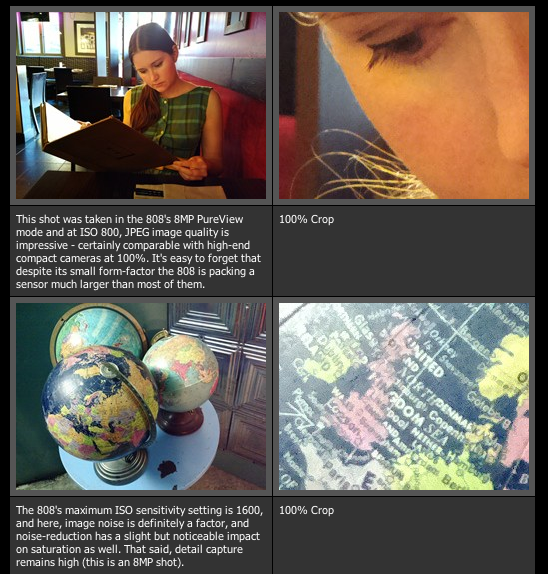DPReview, as you might expect, produced numerous photo samples and even more extensive sets of test conditions and crops that I did:

Here are some choice quotes from the extensive review's conclusion:
In PureView mode, zooming in and out using vertical swipes soon becomes second nature. I'm an iPhone user normally, but zooming with the iPhone's pinch gesture has never felt natural to me (admittedly there is also a tiny zoom 'bar' on the iPhone too, but it's very fiddly). But more importantly, when you zoom in on the 808, you don't have to pay a huge penalty in image quality. Because images aren't upscaled, pixel-level image quality at the extent of the 808's 'zoom' in any given PureView mode is basically the same as it is at 38MP, which is to say that it's not bad at all.
For the majority of shooting situations, the 808's method of simulating an optical zoom works very well, allowing for a degree of flexibility over framing that is simply impossible when taking pictures with other smartphones.
Absolutely, I wrote only a few days ago about the cinematic possibilities when using the Nokia 808, and this applies almost as much to stills as it does to video.
The only major issue that I have with the 808's is highlight clipping. Blown-out highlights are very obvious in scenes with a wide tonal range, and this first-generation PureView phone doesn't offer an equivalent to the 'one shot' dynamic-range expansion settings that are becoming commonplace on other smartphones and compact cameras. In virtually every other respect, the 808 gives excellent image quality considering the type of device that it is. Pixel-level detail is high at low ISO settings and acceptable even at ISO 1600 for non-critical applications. In terms of sharpness and detail, the 808 is more than a match at low ISO settings for most compact cameras (and some DSLRs).
I haven't noticed blown out highlights on photos from my 808, but then extremes of sunlight aren't that common in the UK(!) I'll have to take DPReview's word for it here.
Here's DPReview's final word on the 808 stills camera:
There are inexpensive compact cameras that offer more photographer-friendly features than the 808, but as a cameraphone, the Nokia blows its competition out of the water, and significantly narrows the gap between dedicated cameras and portable communications devices to the point where ultimate convergence seems all but inevitable (and probably sooner than some commentators had realised).
Nokia didn't release the 808 PureView in the hope of making much of a dent in the smartphone market - the Symbian operating system is obsolete, and Nokia's future plans are focussed on Microsoft's Windows Phone OS. If you want an 808 in the USA, you'll have to pay full price ($699) since no carrier (to date) is subsidizing the hardware through contracts on this side of the Atlantic. But while the Nokia 808 might not be an iPhone or Samsung Galaxy killer, it is a fascinating and compelling product, and one that has added a definite shine to Nokia's reputation in the tech industry, which was looking a little tarnished, to say the least.
The 808 proves that Nokia can innovate, and its PureView technology has piqued the interest of serious photographers, being one of the most important innovations - arguable the most important - in mobile photography since the smarphone era dawned five or so years ago. As such, the 808 is intriguing not just in itself, but because of what it represents. Things could be about to get interesting...
Well written and well pitched, guys.
(I'd query the use of the word 'obsolete', of course - only in the sense that no more Symbian handsets will be launched - you can still buy the phones and they're supported for years to come.)
